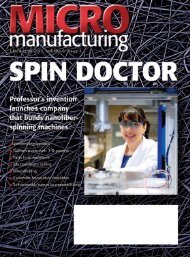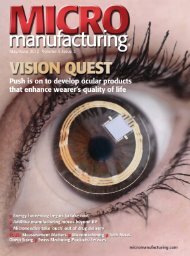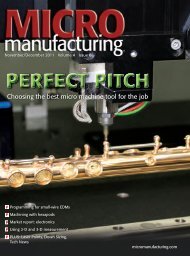Click here to view as PDF - MICROmanufacturing
Click here to view as PDF - MICROmanufacturing
Click here to view as PDF - MICROmanufacturing
Create successful ePaper yourself
Turn your PDF publications into a flip-book with our unique Google optimized e-Paper software.
SAES Memry<br />
SAES Memry’s l<strong>as</strong>er-form stents, often<br />
used for cardiac and PAD angiopl<strong>as</strong>ty, can<br />
accommodate complex geometries.<br />
chining ever-finer stents, a key feature<br />
considering the growing emph<strong>as</strong>is on<br />
minimally inv<strong>as</strong>ive surgical procedures.<br />
Polymer stents<br />
The biggest advantage of the ablation<br />
l<strong>as</strong>er technology may be its ability <strong>to</strong> machine<br />
what many observers are certain is<br />
the future of stent industry: biodegradable<br />
polymer stents. With melting points<br />
ranging between 175° C and 200° C, the<br />
polymer is <strong>to</strong>o fragile <strong>to</strong> be cut with heatb<strong>as</strong>ed<br />
l<strong>as</strong>ers. Unlike metal stents, which<br />
can cause blood clots, the bioabsorbable<br />
devices have thus far proven <strong>to</strong> be without<br />
hazards. A study published in the<br />
March 2009 issue of the medical journal<br />
The Lancet detailed the results of a 2-year<br />
clinical trial of a bioabsorbable DES made<br />
by Abbott Labora<strong>to</strong>ries.<br />
Among the findings:<br />
■ Zero-percent rate of stent thrombosis<br />
(blood-clot formation) for all patients<br />
for 2 years;<br />
■ no occurrence of major adverse<br />
cardiac events between 6 months and<br />
2 years;<br />
■ bioabsorption of the stent 2 years<br />
after implantation;<br />
■ res<strong>to</strong>ration of v<strong>as</strong>omation (ability<br />
of the blood vessel <strong>to</strong> contract and expand);<br />
and<br />
■ reduced plaque in treated arteries.<br />
Recent advances in stent production<br />
have been more evolutionary than revolutionary,<br />
according <strong>to</strong> Frost & Sullivan’s<br />
Rajan. “I think the next leap in technology<br />
will probably be in 6 years or so, if<br />
biodegradable stents [pending FDA approval]<br />
come <strong>to</strong> the market. T<strong>here</strong> are<br />
companies developing them now; they<br />
essentially just dissolve, so t<strong>here</strong>’s no<br />
long-term risk.” µ<br />
About the author:<br />
Daniel McCann<br />
is senior edi<strong>to</strong>r of<br />
MICROmanufacuring.<br />
Telephone: (847) 714-<br />
0177. E-mail: dmccann@<br />
jwr.com.<br />
micromanufacturing.com | 39















